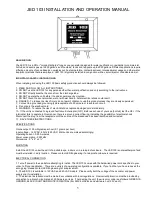
5
104. Cabinet Mounting
104.1 Tools Required
The following tools are required to install the system: Socket Set, Phillips Screwdriver, Diagonal Wire Cutters, Long Nose Pliers, Electrical
Tape, Digital Volt-Ohm Meter, Safety Glasses with Side Shields, Small Punch (K.O. removal), Hammer, Electric Drill, Wood or Masonry Bits,
Level.
104.2 Mounting Hardware
Mounting hardware is not provided. Care should be taken when selecting mounting hardware to assure that it is the proper type for the
application and sized to safely support the systems full weight when installed assuring safe and secure attachment of system to wall
surface. For ease of installation, the factory recommends that the head size of mounting screws or bolts be small enough to pass through
the keyhole K.O.s provided for mounting. This will allow the unit to be hung on partially installed mounting hardware and facilitate easy
cabinet removal if ever necessary.
104.3 Cabinet Clearance
IMPORTANT:
When mounted, the unit requires a minimum of 8 inches (20.3 cm) of clearance on both the right and left hand
sides of the cabinet to assure proper ventilation.
104.4 Knockout Locations
All models provide knockouts on the top and left-hand side of the unit. See
Fig. 1.
Additional entry points, if required can be added using
a metal punch. Do not drill into the cabinet as metal filings can cause short circuits and damage the equipment.
NOTE:
Consider unit knockout locations prior to mounting unit. Allow room for easy routing of conduit to entry point.
Fig. 1
1.25”
(3.18 cm)
1.5”
(3.8 cm)
1.5”
(3.8 cm)
1.25”
(3.18 cm)
0.875” (2.2 cm) Diameter K.O. TYP (4)
Top of Cabinet
Left Side
of Cabinet
1.5”
(3.8 cm)
1.5”
(3.8 cm)































